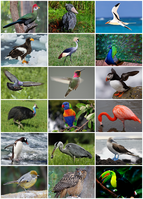
Photo from wikipedia
PREMISE A switch in pollinator can occur when a plant lineage enters a new habitat where the ancestral pollinator is less common and a novel pollinator is more common. Since… Click to show full abstract
PREMISE A switch in pollinator can occur when a plant lineage enters a new habitat where the ancestral pollinator is less common and a novel pollinator is more common. Since pollinator communities vary according to environmental tolerances and availability of resources, there may be consistent associations between pollination mode and specific regions and habitats. Such associations can be studied in lineages that have experienced multiple pollinator transitions, representing evolutionary replicates. METHODS Our study focused on a large clade of Penstemon wildflower species in western North America that has repeatedly evolved hummingbird-adapted flowers from ancestral bee-adapted flowers. For each species, we estimated geographic ranges from occurrence data and inferred environmental niches from climate, topographical, and soil data. Using a phylogenetic comparative approach, we investigated whether hummingbird-adapted species occupy distinct geographic regions or habitats relative to bee-adapted species. RESULTS Hummingbird-adapted species occur at lower latitudes and lower elevations than bee-adapted species, resulting in a difference in their environmental niche. Bee-adapted species sister to hummingbird-adapted species are also found in relatively low elevations and latitudes, similar to their hummingbird-adapted sister species, suggesting ecogeographic shifts precede pollinator divergence. Sister species pairs - regardless of whether they differ in pollinator - show relatively little geographic range overlap. CONCLUSIONS Adaptation to a novel pollinator may often occur in geographic and ecological isolation from ancestral populations. The ability of a given lineage to adapt to novel pollinators may critically depend on its ability to colonize regions and habitats associated with novel pollinator communities. This article is protected by copyright. All rights reserved.
Journal Title: American journal of botany
Year Published: 2022
Link to full text (if available)
Share on Social Media: Sign Up to like & get
recommendations!